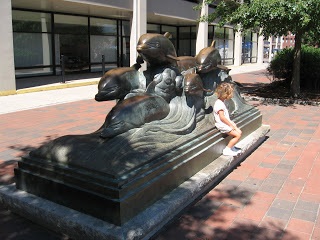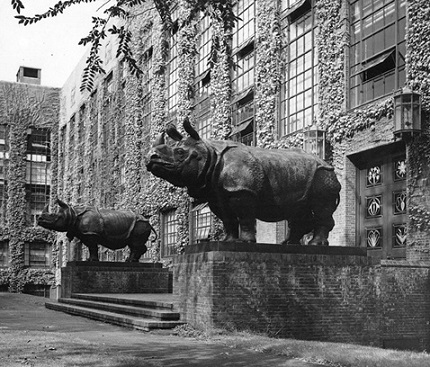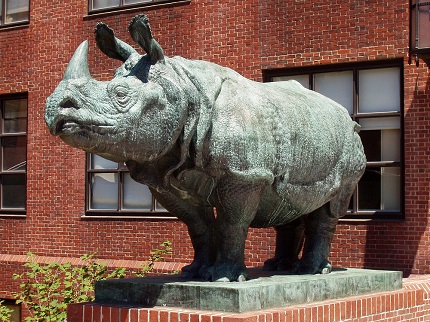
| Print | Back |  |
October 28, 2013 |
 |
Moments in Art Rhinos with Lipstick and Skirtsby Lawrence Jeppson |
To quote the Boston Museum of Science, “During her 70-year career, Katherine Lane Weems broke away from the recognized animal sculptures of her time. She carefully observed the anatomy and behavior of the animals she sculpted. Knowing the shapes and locations of each animal’s muscles, bones, and tendons allowed her to sculpt more realistic animals.”
Like the painter Mary Cassatt, the American member of the original French Impressionist group, Katherine Lane was born into a wealthy family. This allowed her exceptional freedom in pursuing her artistic career.
Her father, Gardiner Martin Lane, was a successful financier and President of the Board of Trustees of the Museum of Fine Arts in Boston. He brought up his daughter, named after an aunt who was a watercolorist, in the world of art.
On a trip abroad her father introduced her to painter John Singer Sargent (1856-1926). Katherine wrote in her memoir Odds Were Against Me, “Mr. Sargent was charming and most kind to me. He explained his work, showed me how he was doing it, and even asked my opinion. It was the first time anyone had treated me like an adult, and I was captivated.”
The Lane family lived in a large house on Marlborough Street, a house that Katherine later (1957) would donate to the French Institute. She attended the upper-crust Miss Mary’s School for Girls, where she was taught what the young women of Boston society should know and how they should act.
Katherine had artistic talent, and her wealth enabled her to study, learn, and work without the economic worries that befall the majority of artists. She was 16 when she began studying drawing at the school of the Museum of Fine Arts. There she studied under Charles Grafly, 1915, and in the summer studio, 1918, of Anna Hyatt Huntington.
Charles Grafly (1862-1929) spent most of his career sculpting and teaching for 37 years at the Pennsylvania Academy of Fine Arts in Philadelphia. Started as an apprentice in a stone yard, he went on to study and win honors in Paris before returning to America. He sculpted notable monuments and busts and was particularly prodigious creating equestrian monuments.
When he was killed by a hit-and-run driver in 1929, Katherine Lane was one of his pallbearers.
Anna Huntington (1876-1973) was daughter of a Harvard professor of paleontology and zoology, which initiated her interest in animal sculpture. Huntington was an inspiration to Katharine and introduced her to the leading figures of the National Sculpture Society. Anna would become, in 1932, the first woman artist elected to the American Academy of Arts and Letters. With her husband she would found Brookgreen Gardens near Myrtle Beach, North Carolina, whose displays are both botanical and sculptural.
Studying with mentors like Grafly and Huntington, Weems’s artistic gift flowered, even though at the time women artists faced open hostility. She discovered a love and flair for sculpting animals. She decided not to seek commissions. “I did not need the money, and I did not want to deprive another artist.” Even so, commissions came her way.
In 1925, she was elected to the National Association of Women Painters and Sculptors, and the next year she won a Bronze Medal at the Philadelphia Sesquicentennial Exposition and the George D. Widener Memorial Gold Medal from the Pennsylvania Academy. She exhibited in a number of galleries in different cities, and her animal work began echoing the sleek, flowing lines of Art Deco.
She became one of the most gifted and successful sculptors of animals in America, the recipient of many commissions, museum acquisitions, accolades, and awards. In 1953, capping decades of achievement, she was elected to the National Institute of Arts and Letters. The Institute was founded in 1898, and fifteen years later was incorporated by an act of Congress to further literature and fine arts. Membership is limited to a total of 250 persons of outstanding merit.
Katharine was 48 when she married Carrington Weems and began showing art under her added name. She was greatly bothered when she learned that dolphins were becoming endangered because they were being caught in the nets of tuna fishermen. By creating an important sculpture depicting them, she could call public attention to their plight. So in 1974, she began sculpting Dolphins of the Sea, a large group of six dolphins.
As she wrote, “I was in my seventy-fifth year when I embarked upon this ambitious and difficult project. I knew it would take time. I was eager to do it, and even though I knew I was in good health, there were moments when I wondered if I would have the strength to finish it.”
It took her five years from her first sketches until Dolphins of the Sea was unveiled in 1979. She was 80. She gave the finished bronze to the Boston Aquarium as her gift to the people. This was not the first or the last instance of her generosity.

She donated her collection of more than 30 bronzes to the Museum of Science, Boston, the largest collection of her work anywhere, to emphasize the closeness of art and science. They are displayed in a permanent gallery.
She was responsible for the donation of millions of dollars’ worth of decorative arts to the Museum of Fine Arts and the endowment of the museum’s Katherine Lane Weems curatorial chair for American Decorative Arts and Sculpture, a chair first occupied by Jonathan Leo Fairbanks, her long-time friend, who recently donated her Camels to the Fuller Craft Museum.
To go back a bit in the chronology, in 1930, young Katharine received her first really big commission — animating the exterior of the new red-brick Harvard University Biological Laboratory. Funded by a lavish two million dollar grant from the Rockefeller Foundation, the new building would house state-of-the-art facilities.
Harvard President A. Lawrence Lowell wanted a building that would be far from ordinary. To give it sufficient éclat, Katherine, who was only 30, was awarded three coveted commissions: the three large sculpted bronze doors at the entrance, an animal frieze along the front of the building at the top, and two large animals, which would be cast in bronze.
That these were rhinoceroses had not yet been determined.
In preparation, Katherine studied animals at the Bronx Zoo in New York City and researched Japanese and Chinese animal depictions, particularly those from Chinese Han dynasty tombs. The bronze doors depicted various land, sea, and air species. Using pneumatic drills and a team of workmen, she sculpted a linear frieze across the top story of the brick building, stringing out more than 30 animals representing "four of the world’s zoographic zones."
Two empty pedestals stood in front of the building. The architect thought they should be occupied by two large animals, but he didn’t know what kind. The choice was left to the young sculptor. She chose to depict the largest specimens ever recorded of an Indian species, Rhinoceros unicornus. She fashioned two large, three-ton bronze rhinos, which became affectionately known as Bessie and Victoria, possibly her most popular creations.
Bessie and Victoria took the young artist five years to complete and were dedicated in 1937.

In 2003, they were removed from the courtyard to prevent their being damaged while Harvard’s new Mouse Laboratory was built. Like the Smithsonian’s Sackler Museum and Paris’s Marmottan, there was insufficient room to build above ground. A deep hole was excavated so the multi-storied Mouse Lab could be built underground. The Mouse Lab and the Biological Laboratories were united under a new name, the Department of Molecular and Cellular Biology.
After two years in protective exile, Bessie and Victoria were returned. In 2007, the department held a 70th birthday celebration for Bessie and Victoria featuring festivities and noted speakers.
To add to the spirit, the two three-ton bronze rhinos were decorated with makeup, jewelry, and skirts!
(On Halloweens — and probably other occasions — the pair are appropriately decorated, perhaps by unofficial celebrants.)

| Copyright © 2025 by Lawrence Jeppson | Printed from NauvooTimes.com |